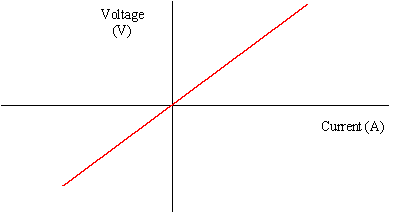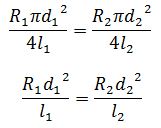How to solve questions on current of electricity for Cambridge A level

How to solve questions on current of electricity for Cambridge A level
Question 1
A heater is made from a wire of resistance 18.0 Ω and is connected to a power supply of 240 V. The heater is switched on for 2.60 Ms.{Cambridge A level 2013 p22}
Calculate
(i) the power transformed in the heater,
(ii) the current in the heater,
(iii) the charge passing through the heater in this time,
(iv) the number of electrons per second passing a given point in the heater.
Solution
i. P = v2 / R = 240 *240 / 18 = 3200 watt
ii. v = IR
I = v / R = 240 / 18 = 13.3 A
iii. Q = It
Q = 13.3 * 2.6 x 1o^6 = 34.7 x 10^6 c
iv It = ne
n/t = I/e = 13.3 / 1.6 x 10^-19 = 8.33 x 10^6 s-1
Recommended: More solved questions on current of electricity
Question 2
An iron wire has length 8.0 m and diameter 0.50 mm. The wire has resistance R. A second iron wire has length 2.0 m and diameter 1.0 mm. What is the resistance of the second wire?{Cambridge A level 2012 p11}
A. R / 16 B. R/8 C. R / 2 D. R
solution
Since they are of the same material, they will have the same resistivity
R1A1 /L1 = R2A2 / L2

R * 0.5 * 0.5 / 8 = R2 * 1 * 1 / 2
R2 = 2*R*0.5*0.5 / 8
R2 = R / 16
A is the correct option
Question 3
An electric heater is to be made from nichrome wire. Nichrome has a resistivity of 1.0 × 10–6 Ω m at the operating temperature of the heater. The heater is to have a power dissipation of 60 W when the potential difference across its
terminals is 12 V.
(a) For the heater operating at its designed power,
(i) calculate the current,
(ii) show that the resistance of the nichrome wire is 2.4 Ω.
(b) Calculate the length of nichrome wire of diameter 0.80 mm required for the heater.
(c) A second heater, also designed to operate from a 12 V supply, is constructed using the same nichrome wire but using half the length of that calculated in (b). Explain quantitatively the effect of this change in length of wire on the power of the heater. {Cambridge A level 2010 p21}
Solution
P = Iv
60 = I * 12
I = 60 / 12
I = 5 A
ii.
V = IR
R = v / I
R = 12 / 5
R = 2.4 Ω
b.
R = pl /A
l = RA/ p

l =( 2.4 * 3.142 * 0.8 x 10^-3 * 0.8 x 10 ^-3) / 4 * 1 x 10^-6
L = 1.21 m
C.
The resistance and the length are directly proportional
when the length is halved, the resistance will be halved
resistance and current are inversely proportional
reduction in value of resistance means more current will flow. since the resistance has been halved, the current will be doubled.
since second heater also operated on a 12v supply, the power will be doubled because the current has been doubled i.e they are directly proportional.
Question 4
A source of e.m.f. of 9.0 mV has an internal resistance of 6.0 Ω. It is connected across a galvanometer of resistance 30 Ω. What will be the current in the galvanometer?{Cambridge A level 2010 p11}
A 250 μA B 300 μA C 1.5 mA D 2.5 mA
Solution
E.m.f = I(R + r)
9 x 10^-3 = I(6 + 30)
0.009 = 36I
I = 0.009 / 36
I = 0.00025 A = 250μA
A is the correct answer
Question 5
A 12 V battery is charged for 20 minutes by connecting it to a source of electromotive force (e.m.f.). The battery is supplied with 7.2 × 104J of energy in this time. How much charge flows into the battery?{Cambridge A level 2009 p1}
A 5.0 C B 60 C C 100 C D 6000 C
Solution
Energy = power x time
power = Iv
E = Ivt
Q = It
E = Qv
Q = E /v
Q = 7.2 x 10^4 / 12
Q = 6000 C
D is the correct answer
Recommended: Note on current of electricity
